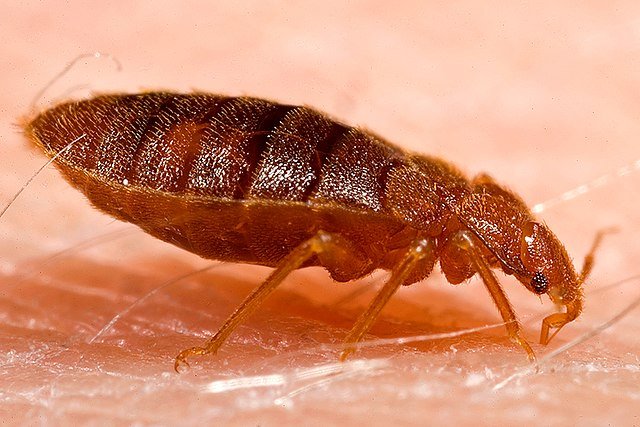The Ultimate Guide to Household Pests: Identification, Risks, and Control
 With more than 2 million species of insects and countless animal pests, we truly live on a planet of pests. As long as they don’t bother us and stay outside our space, we have no right to interfere with them. But often they become unwanted visitors inside our homes. That’s when we need to take targeted action—careful measures that do not extend beyond the boundaries of our living space.Household pests are not a local issue; they are a universal problem. Wherever people live, pests follow. Some feed on our food, some live off our pets, some gnaw at our buildings, and others simply share our space because we provide shelter and warmth.
With more than 2 million species of insects and countless animal pests, we truly live on a planet of pests. As long as they don’t bother us and stay outside our space, we have no right to interfere with them. But often they become unwanted visitors inside our homes. That’s when we need to take targeted action—careful measures that do not extend beyond the boundaries of our living space.Household pests are not a local issue; they are a universal problem. Wherever people live, pests follow. Some feed on our food, some live off our pets, some gnaw at our buildings, and others simply share our space because we provide shelter and warmth.
In Southern Europe, USA, Australia, South America, pests like cockroaches, mice, rats, bed bugs, fleas, pigeon lice, pigeons, ants, and mosquitoes are the most common. But the broader picture is global: households in every region fight similar invaders, with some regional variations like termites in warmer areas, sever cockroaches infestations in Mediterranean climates, rats in UK, or silverfish in damp apartments everywhere in the world.
This guide is designed to be a complete resource: how to recognize common household pests, the risks they bring, and how to prevent or control them effectively.
Why Household Pests Matter
It’s easy to dismiss pests as “just a nuisance.” But the truth is they touch three core areas of daily life:
Health risks – Many pests transmit pathogens, trigger allergies, or carry parasites.
Structural damage – Rodents, termites, and carpenter ants can quietly destroy property.
Quality of life – Lack of sleep from bed bugs, stress from cockroaches, or pigeon droppings on your balcony all reduce well-being.
Ignoring them rarely works. Populations grow quickly, and what starts as a few insects can escalate into an infestation that demands professional intervention.
Cockroaches: The Classic Kitchen Invader
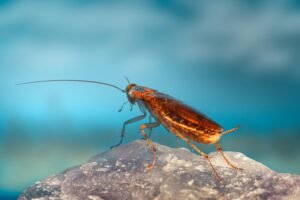 Cockroaches are perhaps the most hated home pests. Two are very common: the small German cockroach, which multiplies explosively indoors, and the larger American and Oriental cockroaches, often emerging from drains.
Cockroaches are perhaps the most hated home pests. Two are very common: the small German cockroach, which multiplies explosively indoors, and the larger American and Oriental cockroaches, often emerging from drains.
Identification
German cockroach: 1–1.5 cm, light brown, two dark stripes on the back.
American cockroach: up to 4 cm, reddish brown, prefers basements and drains.
Oriental cockroach: dark, glossy, sometimes called “water bug.”
All are nocturnal and extremely fast movers.
Risks
Spread bacteria like Salmonella and E. coli.
Trigger asthma and allergies in sensitive individuals.
Contaminate kitchens, pantries, and utensils.
Control
Sanitation: eliminate crumbs, seal food, keep sinks clear.
Exclusion: seal cracks, fix leaks, install drain covers.
Baits: slow-acting gels are highly effective.
Monitoring: sticky traps to gauge infestation level.
Professional treatments: often needed for German cockroaches due to rapid breeding.
FAQ
Q: Why do I see cockroaches in the day?
A: Because the colony is overcrowded and hiding spots are full.
Q: Do sprays work?
A: Sprays kill on contact but rarely solve infestations; baits target the colony.
Q: Can cockroaches survive without food?
A: Up to a month, but without water only about a week.
Mice and Rats: Silent Destroyers
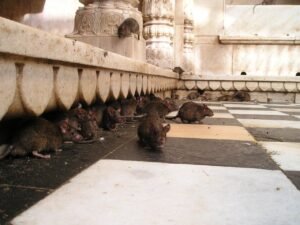 Rodents are among the most dangerous household pests. Mice and rats contaminate food, spread diseases, and cause costly structural damage.
Rodents are among the most dangerous household pests. Mice and rats contaminate food, spread diseases, and cause costly structural damage.
Identification
House mouse: 6–10 cm, large ears, small droppings like rice grains.
Norway rat (brown rat): 20–25 cm, thick tail, blunt droppings.
Roof rat (black rat): slimmer body, pointed snout, good climber.
Risks
Spread pathogens (e.g., leptospirosis, salmonella).
Gnaw wires, creating fire hazards.
Damage insulation, food supplies, and even furniture.
Control
Exclusion: seal entry points; mice can squeeze through holes the size of a coin.
Sanitation: store food in rodent-proof containers.
Traps: snap traps and electronic traps are humane and effective.
Rodenticides: restricted in many countries; always follow local laws.
FAQ
Q: How do I know if I have mice or rats?
A: Droppings are the best clue: small and pointed for mice, large and blunt for rats.
Q: Do rats climb into houses?
A: Yes, roof rats enter via trees, cables, and attics.
Q: Are rats more dangerous than mice?
A: Both carry risks, but rats cause more extensive structural damage.
Bed Bugs: The Blood-Sucking Hitchhikers
 Bed bugs are small, flat insects that feed on human blood at night. Once nearly eliminated in Europe and North America, they have resurged due to global travel and resistance to pesticides.
Bed bugs are small, flat insects that feed on human blood at night. Once nearly eliminated in Europe and North America, they have resurged due to global travel and resistance to pesticides.
Identification
5–7 mm long, reddish-brown, flat.
Swell after feeding, becoming more rounded.
Signs: blood spots on sheets, dark fecal dots, shed skins, musty odor.
Risks
Bites cause itching, welts, and allergic reactions.
Infestations spread quickly between apartments or hotel rooms.
Sleep loss and anxiety are common side effects.
Control
Inspection: check seams, bed frames, nearby furniture.
Heat treatment: lethal at 50°C; professionals use chambers or heaters.
Steam and vacuuming: useful for cracks and fabrics.
Professional extermination: usually necessary.
FAQ
Q: Do bed bugs live only in dirty homes?
A: No, they infest clean or dirty places equally.
Q: Can I get rid of them alone?
A: Rarely. Professional help is usually required.
Q: Do they spread diseases?
A: Not confirmed, but their bites can cause allergic issues.
Fleas: Tiny Jumping Parasites
Fleas are wingless, blood-feeding insects that affect both animals and humans. Cat fleas are most common, often carried by stray cats.
Identification
2–3 mm, reddish-brown, laterally flattened.
Powerful jumpers.
Eggs fall off hosts into carpets, furniture, and cracks.
Risks
Cause itchy bites on humans and pets.
Transmit parasites (like tapeworms).
Historically vectors of plague.
Control
Pets: treat cats and dogs with vet-approved products.
Environment: vacuum carpets, wash bedding in hot water.
IGRs: stop larvae developing.
Professional fumigation: needed in severe infestations.
FAQ
Q: How long do fleas live without a host?
A: Several weeks, depending on conditions.
Q: Do fleas infest humans permanently?
A: No, they bite humans but prefer furry hosts.
Q: Why do fleas keep coming back?
A: Eggs and pupae in the environment keep emerging; repeated cleaning is needed.
Pigeons and Pigeon Lice
Pigeons are considered “flying rats” in many cities. Their droppings and nesting bring parasites and health risks.
Identification
Adult pigeons are 30–35 cm, gray-blue plumage.
Pigeon lice (bird mites) are tiny insects from nests.
Risks
Droppings corrode stone and metal.
Nests harbor mites, fleas, beetles.
Diseases: fungal spores from droppings can cause respiratory illness.
Control
Exclusion: nets, spikes, sloped surfaces.
Removal: clean nests with protective equipment.
Professional control: permanent bird management systems.
FAQ
Q: Do pigeon lice bite people?
A: Yes, when deprived of birds, but they don’t live long on humans.
Q: Are droppings dangerous?
A: Yes, inhaling dust from droppings can cause lung disease.
Q: What’s the best prevention?
A: Keep balconies and ledges clear; use deterrents.
Ants: Small but Organized
Ants are everywhere. In Greek homes the most common species is the black garden ant, which marches in trails toward crumbs of bread or sugar. But worldwide, ants range from harmless nuisance species to carpenter ants (wood destroyers) and fire ants (dangerous stingers).
Identification
Workers: 2–15 mm depending on species.
Black garden ant: shiny, black, forms long foraging trails.
Carpenter ant: larger, black/red, often found near wood.
Fire ant: reddish, aggressive, painful sting.
Risks
Contaminate food by walking over surfaces and leftovers.
Carpenter ants weaken wood by excavating galleries.
Fire ants sting, causing allergic reactions and serious pain.
Control
Find the nest: spraying trails kills a few workers, but not the colony.
Baits: slow-acting food laced with insecticide, carried back to the queen.
Exclusion: seal entry points around doors, windows, and pipes.
Outdoor management: trim plants touching walls, remove rotting wood.
FAQ
Q: Do ant baits really work?
A: Yes, but they need time—workers must feed the colony before results show.
Q: Why do ants suddenly appear in my kitchen?
A: They follow pheromone trails to food; even one crumb can start a trail.
Q: Can carpenter ants be as bad as termites?
A: Termites eat wood, carpenter ants excavate it. Both can cause serious damage if left unchecked.
Mosquitoes: The Seasonal Menace
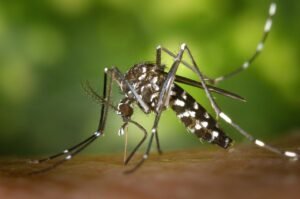 Mosquitoes are among the most hated pests in summer. Besides itchy bites, they are also known vectors of dangerous diseases in many regions.
Mosquitoes are among the most hated pests in summer. Besides itchy bites, they are also known vectors of dangerous diseases in many regions.
Identification
Slender flies with long legs and wings.
Only females bite, needing blood to produce eggs.
Lay eggs in standing water: buckets, gutters, puddles, even bottle caps.
Risks
Spread diseases: malaria, dengue, West Nile virus, Zika (depending on country).
Cause allergic reactions in sensitive individuals.
Disrupt outdoor activities and sleep.
Control
Eliminate breeding sites: empty containers, clean gutters, fix drainage.
Exclusion: mosquito screens on doors and windows.
Repellents: DEET, picaridin, IR3535; citronella for short-term outdoor use.
Larvicides: used in water bodies where draining isn’t possible.
FAQ
Q: Do all mosquitoes bite?
A: No, only females feed on blood; males eat nectar.
Q: Are mosquitoes active only at night?
A: Many bite at dusk and dawn, but species like Aedes aegypti are day biters.
Q: Why are there so many around my house?
A: Standing water nearby is the most common reason.
Flies in the House
Introduction
 Flies are among the most common and annoying household pests. From kitchens to garbage bins, they seem to appear out of nowhere, especially in summer.
Flies are among the most common and annoying household pests. From kitchens to garbage bins, they seem to appear out of nowhere, especially in summer.
Identification
House fly (Musca domestica): grey body, 6–7 mm, red eyes.
Fruit fly (Drosophila): tiny, reddish eyes, attracted to ripe fruit.
Drain fly: fuzzy moth-like appearance, lives in sinks and drains.
Cluster fly: larger, slow-moving, enters attics in autumn.
Risks
Spread pathogens like Salmonella, E. coli, dysentery.
Contaminate food surfaces by vomiting and defecating while feeding.
Cluster flies don’t spread disease but swarm and cause nuisance.
Control
Sanitation: cover food, clean bins, fix drains.
Exclusion: window screens, door sweeps.
Traps: UV fly traps, sticky strips, homemade vinegar traps for fruit flies.
Professional help: fogging or targeted insecticides in severe infestations.
FAQ
Q: Why are there so many flies in my house suddenly?
A: Likely breeding source nearby—garbage, drains, or rotting fruit.
Q: Are flies dangerous to health?
A: Yes, they carry bacteria and contaminate food.
Q: Do fruit flies come from drains?
A: Some do (drain flies), but many breed on ripe/fermenting fruit.
Wasps Around the Home
Introduction
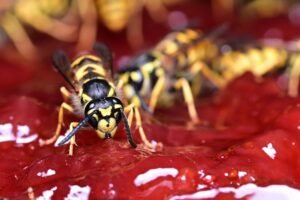 Wasps are feared for their sting and tendency to nest close to people. In warm months they are frequent visitors to gardens, balconies, and kitchens.
Wasps are feared for their sting and tendency to nest close to people. In warm months they are frequent visitors to gardens, balconies, and kitchens.
Identification
Common wasp: yellow and black stripes, aggressive near nests.
Hornets: larger, reddish-brown and yellow, painful sting.
Paper wasps: slender body, build umbrella-like nests under eaves.
Risks
Stings are painful, may cause allergic reactions or even anaphylaxis.
Aggressive near nests—attack in numbers if disturbed.
Indoor nests (attics, wall voids) damage structures.
Control
Prevention: keep bins sealed, cover sweet foods and drinks outdoors.
Exclusion: seal cracks, block roof entry points.
Nest treatment: never attempt large nest removal yourself; call professionals.
Traps: bottle traps with sweet liquid bait reduce numbers in gardens.
FAQ
Q: Are wasps good for anything?
A: Yes, they eat other insects, but near homes they become dangerous.
Q: How do I remove a wasp nest safely?
A: Small nests early in the season can be treated at night with sprays, but bigger ones need professionals.
Q: What’s the difference between bees and wasps?
A: Bees are fuzzy pollinators, generally not aggressive; wasps are smooth-bodied predators, easily provoked.
Other Pests to Watch
Not all pests fall into the “classic” list, but many homes eventually face these invaders.
Termites
Identification: pale, ant-like insects that live in hidden colonies.
Risks: silently destroy wooden structures; billions in damage worldwide.
Control: regular inspections, soil barriers, baiting systems. DIY is not effective.
Silverfish
Identification: small, silver-gray insects with fish-like movements.
Risks: feed on paper, books, starch-based materials.
Control: reduce humidity, clean storage, traps for monitoring.
Widow-Type Spiders
Identification: shiny black spiders with red or orange markings. In Southern Europe, the Mediterranean black widow is known; in Australia, the redback.
Risks: venomous bites can be serious, though rarely fatal with modern care.
Control: avoid clutter, wear gloves when cleaning sheds/woodpiles.
Scorpions
Identification: arachnids with pincers and a stinger tail.
Risks: painful stings; some species medically important.
Control: remove debris piles, seal entry points, keep yards tidy.
Earwigs
Identification: Earwigs are brown insects with pincers on the abdomen.
Risks: mostly nuisance; minor damage to plants.
Control: reduce moisture, clean debris, use rolled paper traps.
Sowbugs and Pillbugs (Woodlice)
Identification: gray, segmented crustaceans; pillbugs can roll into a ball.
Risks: mostly harmless, feed on decaying matter; may bother seedlings indoors.
Control: fix moisture problems, reduce mulch, improve ventilation.
Stored-Product Pests
Identification: moths, weevils, or beetles infesting pasta, rice, flour, nuts, spices.
Risks: contaminate stored food supplies.
Control: airtight jars, first-in-first-out rotation, freeze or discard infested items.
Clothes Moths and Carpet Beetles
Identification: moths and beetle larvae attack fabrics and carpets.
Risks: damage wool, fur, stored clothing.
Control: clean fabrics before storage, use sealed containers, vacuum regularly.
Why These “Other Pests” Matter
It’s tempting to dismiss some of these as rare. But in reality:
Termites cause enormous financial damage, even in countries where they are less common.
Silverfish quietly destroy archives, libraries, and family photo albums.
Stored-product pests are a constant threat to pantries and food businesses.
Spiders, scorpions, and earwigs create fear and discomfort that directly reduce quality of life.
Understanding these less obvious pests gives you a complete picture of what can threaten a household.
All-Purpose Prevention Strategies
While each pest has its quirks, most infestations succeed because of three things: food, water, shelter. Break that triangle, and you’ve already done half the job.
Sanitation
Store all dry goods (rice, pasta, flour, cereals) in airtight jars.
Wash dishes immediately, don’t leave dirty plates overnight.
Take out garbage daily, especially in summer.
Vacuum crumbs from couches, carpets, and under appliances.
For pet owners: keep feeding bowls clean and don’t leave excess kibble.
Moisture Control
Fix leaky faucets and pipes quickly.
Use dehumidifiers in damp basements.
Keep bathrooms ventilated; wipe condensation from windows.
Outdoors: clean gutters, repair broken drainage, eliminate puddles.
Exclusion
Seal cracks in walls, especially around pipes and cables.
Install mesh on vents and drains.
Fit door sweeps and weather stripping on exterior doors.
Use mosquito screens on windows.
Structural & Outdoor Maintenance
Keep firewood off the ground and away from the house.
Trim vegetation so it doesn’t touch walls or roofs.
Clean up yard debris and stacked junk that creates harborages.
Inspect attics and basements twice a year for signs of pests.
Monitoring
Place sticky traps behind appliances, in basements, and in cupboards to detect early signs.
Keep a “pest diary”: note when and where you see activity. This helps you and professionals understand the pattern.
The key principle: it’s easier and cheaper to prevent pests than to eliminate a full infestation.
Extended FAQ for Household Pests
Q: What is the most dangerous household pest worldwide?
A: Mosquitoes, because of their role in spreading deadly diseases. For property, termites and rodents cause the greatest damage.
Q: Are natural remedies enough?
A: Vinegar, baking soda, diatomaceous earth, and essential oils can reduce numbers but rarely solve large infestations. Use them for prevention or light cases.
Q: Why do pests keep coming back after I clean?
A: If food, water, or shelter remain available, they will return. Sanitation and exclusion must be continuous.
Q: Do ultrasonic pest repellers work?
A: Scientific studies show little consistent effect. Some rodents may avoid them briefly but usually get used to the sound.
Q: Are chemical sprays safe to use at home?
A: Only if used strictly according to the label. Overuse or misuse can create health risks. Always ventilate, and never exceed the recommended dose.
Q: How can I know if a pest problem is too big for DIY?
A: Signs include: pests visible during the day, recurring bites, structural damage, or droppings in multiple rooms. At that point, professional service is best.
Q: Can pests spread through apartment buildings?
A: Yes. Bed bugs, cockroaches, and rodents often move through pipes, cables, and shared walls. Coordinated control may be needed.
Q: How much does professional pest control cost?
A: Prices vary by country and type of pest, but consider it an investment: one treatment can prevent thousands in structural damage or medical bills.
Q: Do pests mean my home is dirty?
A: Not necessarily. Bed bugs, for example, infest five-star hotels. Cleanliness helps, but pests often just follow shelter and warmth.
Q: Which pests are seasonal?
A: Mosquitoes peak in summer, cluster flies in autumn, ants in spring, and rodents often seek shelter in winter. Cockroaches and bed bugs can be active year-round indoors.
Final Thoughts
Household pests are part of urban and rural life. From cockroaches hiding in kitchens to mosquitoes buzzing at night, the fight is constant. The good news: with a mix of prevention, early detection, and smart control measures, most infestations can be managed before they spiral out of control.
Whether you handle things yourself or call in a professional, remember that pest control is not a one-time event. It’s an ongoing process of keeping your living space clean, dry, and sealed.
Disclaimer
This article is for informational purposes only. Pest control laws and approved chemicals vary by country. For best results and legal safety, we strongly recommend contacting a licensed pest control professional in your local area. Always make sure that the pest control technician is properly certified or licensed, depending on your country’s regulations. It’s important to confirm that they only use approved products and apply them exactly as instructed on the product label. In most places in Europe, UK, or USA, following label directions is not just best practice—it’s the law.
Author
Nasos Iliopoulos
MSc Agronomist & Certified Pest Control Expert
Scientific Director, Advance Services (Athens, Greece)
Licensed Pest Control Business – Ministry of Rural Development & Food (GR)
References
Colorado State University – Household Pests
University of Minnesota Extension – Insects in the Home
Purdue University Extension – Structural Pests
CDC – Vector-Borne Diseases

